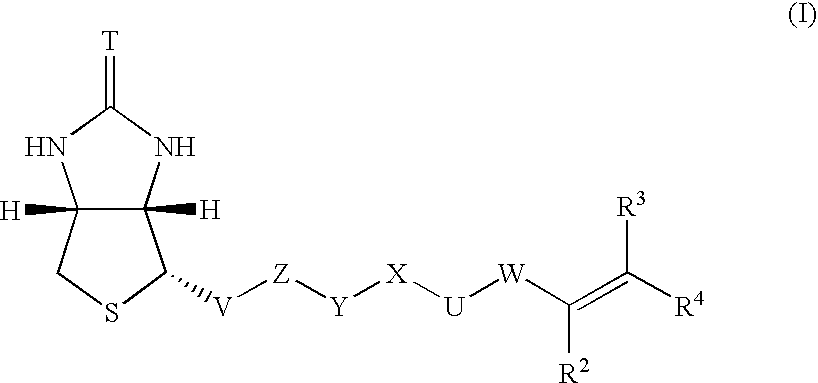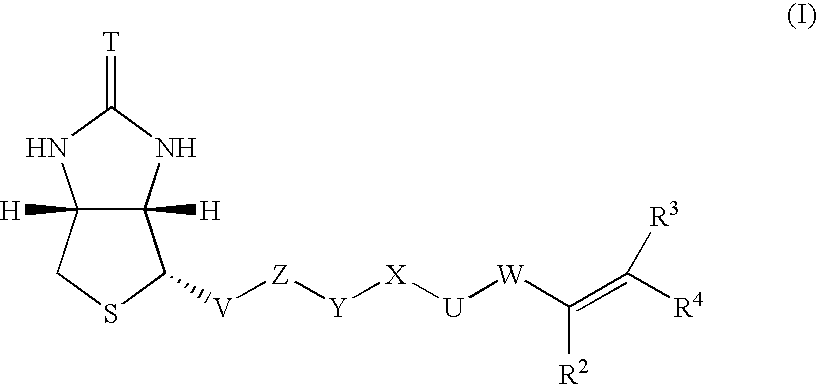Polymerizable biotin derivatives, biotin polymer, and polymer responsive to avidin stimulation
- Summary
- Abstract
- Description
- Claims
- Application Information
AI Technical Summary
Benefits of technology
Problems solved by technology
Method used
Image
Examples
example 1
Synthesis of 2-biotinylethyl acrylate (Compound A)
[0093]At room temperature, 500 mg of biotin (Compound i, product of Merck & Co., Inc.), 200 mg of 2-hydroxyethyl acrylate, 20 ml of thionyl chloride and 20 ml of toluene were mixed. The resulting mixture was refluxed for 2 hours. The solvent was then distilled off under reduced pressure. The residue was subjected to column chromatography by using a chloroform-methanol solvent mixture. By removal of the solvent, 100 mg of 2-biotinylethyl acrylate (Compound A) was obtained as a powdery substance (yield: 14%).
[0094]NMR analysis clearly indicated the existence of the target compound A (in DMSO).
NH and acrylic group bonding H:5H, δ5.8–6, 6a, 3a, OCH2:6H, multi, δ4.1–4.3, 6α:1H, multi, δ3.1, 6β:1H, d, δ 2.8, CH2:8H, δ1–1.6.
example 2
Synthesis of N-biotinyl-N′-methacroyltrimethylene amide (Compound B)
[0095]In 300 ml of N,N-dimethylformamide (DMF) were dissolved 18 g of N-(3-aminopropyl)methacrylamide hydrochloride (Compound iii), 24 g of biotin and 30 g of triethylamine, followed by cooling to 0° C. To the reaction mixture, a solution obtained by dissolving 28 g of diphenylphosphoryl azide in 50 ml of DMF was added dropwise over 1 hour. After completion of the dropwise addition, stirring was conducted at 0° C. for 3 hours and then at room temperature for 12 hours. After completion of the reaction, the solvent was distilled off and the residue was subjected to column chromatography by using a chloroform-methanol mixture as a developing solvent. As a result, 22 g of N-biotinyl-N′-methacroyltrimethylene amide (Compound B) was obtained as the target compound in the form of a white powder (yield: 59%).
[0096]NMR analysis clearly indicated the existence of the target compound B (in DMSO).
CONH:2H, br.s, δ7.9, NH, NH:2H,...
example 3
Synthesis of N-iminobiotinyl-N′-methacroyltrimethylene amide (Compound C)
[0097]In a similar manner to Example 2 except for the use of 18 g of N-(3-aminopropyl)methacrylamide hydrobromide instead of 18 g of the N-(3-aminopropyl)methacrylamide hydrochloride obtained in Example 2 and 24 g of iminobiotin instead of 24 g of biotin, 15 g of hydrobromide of N-iminobiotinyl-N′-methacroyltrimethylene amide (Compound C) was obtained (yield: 42%).
[0098]NMR analysis clearly indicated the existence of the hydrobromide of the target compound C (in DMSO). NH, NH:2H, d, δ 8.0–8.2, CONH:2H, br.s, δ 7.9, ═NH.HBr:2H, s, δ 7.5, H2, H3:2H, s, δ 5.6, δ5.3, 3a, 6a:2H, br.d, δ 4.2, CH2:4H, s, δ 3.0, 6α, 6β:2H, multi, δ 2.8, 4H:1H, multi, δ 2.6, COCH2:2H, br.s, δ 2.1, CH3:3H, δ 1.8, CH2:8H, δ 1.2–1.5.
PUM
| Property | Measurement | Unit |
|---|---|---|
| Temperature | aaaaa | aaaaa |
| Temperature | aaaaa | aaaaa |
| Fraction | aaaaa | aaaaa |
Abstract
Description
Claims
Application Information
 Login to View More
Login to View More - R&D
- Intellectual Property
- Life Sciences
- Materials
- Tech Scout
- Unparalleled Data Quality
- Higher Quality Content
- 60% Fewer Hallucinations
Browse by: Latest US Patents, China's latest patents, Technical Efficacy Thesaurus, Application Domain, Technology Topic, Popular Technical Reports.
© 2025 PatSnap. All rights reserved.Legal|Privacy policy|Modern Slavery Act Transparency Statement|Sitemap|About US| Contact US: help@patsnap.com



